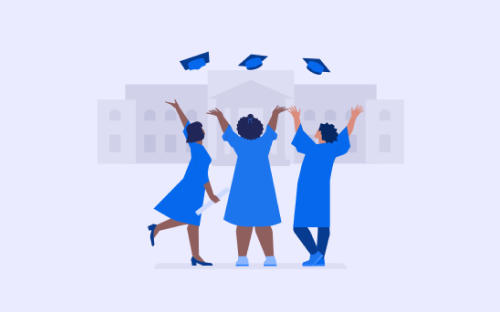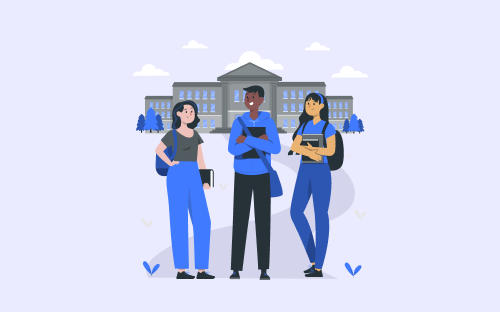 Highlights
Highlights
Here are the key details related to studying in USA
Why Study in USA?

Top Universities
The USA is home to some of the world’s best universities, offering you cutting-edge programmes and a chance to learn from renowned professors.

Campus Culture and Safety
Enjoy a vibrant campus life with a focus on student safety and an inclusive atmosphere.

Standard of Living
Experience a high standard of living with access to modern amenities, healthcare facilities, and exciting cultural experiences.

Thriving Innovation Hub
The US is a global leader in research and development. Studying here puts you at the forefront of innovation.

High ROI
A degree from the USA opens doors to global career opportunities, making it a worthwhile investment in your future.
Popular Places to Study in USA
The USA is home to some of the world's most renowned universities and diverse cities such as Boston, New York, and San Francisco, making it a popular destination for international students.
These cities offer a unique blend of world-class education, vibrant culture, and exciting career opportunities, making them ideal for students seeking a fulfilling academic and personal experience.
A comprehensive list of these top-ranked US student cities can be found in the following section.
Study in USA for Indian Students: Application Process 2025
Self-Assessment and Research
Determine your desired field of study and degree level (undergraduate, postgraduate, or doctorate).
Consult with an Education Counsellor
Consult an education counsellor to discuss your academic background, career goals, and study abroad aspirations.
Language Proficiency
Assess your English proficiency level to determine if language tests are required.
Prepare Application Materials
Obtain official transcripts from previous institutions.
Apply to Universities
Complete online applications for your chosen universities, including submitting required documents.
Visa Application
Ensure you meet the requirements for a Canadian study permit
Pre-Departure Preparations
Arrange on-campus housing or find suitable off-campus accommodation.
Arrival and Settlement
Check-in at your university's orientation and complete the necessary formalities.
Education System in USA
The education system in the United States includes elementary school (K-5), middle school (Grades 6-8), and high school or secondary education (Grades 9-12). After completing high school, students typically pursue higher education at different types of colleges and universities, including public colleges, private colleges, and prestigious Ivy League schools.
Variety of courses available in USA
Academic Calendar to study in USA
Here's what to expect if you want to study in USA
Fall Semester (September - December)
This main academic term includes classes, assignments, and campus life. Layer up as temperatures drop, especially towards December!
Winter Break (December - January)
Enjoy a well-deserved break over the holidays. It's a time to relax, recharge, and spend time with family and friends.
Spring Semester (January - May)
Dive back into your studies after the winter break. This term builds on the fall semester and leads up to final exams.
Spring Break (March)
A mid-semester break to recharge. Enjoy a week off to travel, relax, or catch up on coursework.
Summer (May - August)
Final exams wrap up the academic year. After graduation or the end of classes, enjoy the long summer break!
Top Universities in USA
View allIntakes in USA
The US is a top destination for international students, thanks to its leading position in the global education sector. American universities typically operate on an intake system.
The primary intake for studying in the USA is the fall intake, which usually begins in late August or early September. It marks the start of the academic year and has an acceptance rate of 99% in many US universities.
US universities have three main intakes for admitting students each year.
Fall Intake
September'25 - December'25
- Offers the widest range of programs
- Perfect if you're ready to dive right in

Spring Intake
January'25 - April'25
- For students who have missed their admission fall intake
- High chances of admission due to lower competition.

Summer intake
May'25 - August'25
- Last intake session for the academic year
- Smaller batch size ensure more focussed and personalised attention.

Student Visa Requirements for USA
The USA provides three types of student visas based on age and study level. The F-1 visa is for studying at accredited colleges, universities, or English language institutes. The J visa supports exchange programs, while the M visa is for vocational or non-academic training. Among these, the F-1 visa is the most popular, offering students the opportunity to students to study at top US universities.
Eligibility Criteria to Study in USA
- Acceptance to a SEVP-approved school: You must be accepted into an academic program at a school certified by the Student and Exchange Visitor Program (SEVP).
- Full-Time Enrollment: You must be enrolled as a full-time student in an academic program.
- English Proficiency: While not a strict requirement, most U.S. universities require proof of English proficiency through tests like TOEFL or IELTS.
- Proof of Financial Support: You must demonstrate that you have sufficient funds to cover tuition fees, living expenses, and other costs during your stay in the USA.
Required Documents to Study in USA
- Valid Passport: Ensure it's valid for at least six months beyond your intended stay in the U.S.
- Form I-20: This is issued by your U.S. school and is proof of your acceptance into an academic program.
- SEVIS fee payment receipt: This is a fee paid to the Student and Exchange Visitor Program (SEVP).
- DS-160 Confirmation Page: This is generated after you complete the online visa application form.
- Proof of financial support: It includes bank statements, scholarships, assets, income and more such documents.
- Passport-Sized Photo: This should adhere to specific guidelines provided by the U.S. Consulate.
- Academic Documents: Transcripts, degree certificates, standardised test scores (e.g., TOEFL, GRE, SAT), and proof of admission.
Additional Documents to Study in USA
- Letters of recommendation
- Standardised test scores (required by some schools)
- Evidence of your intent to return to your home country after completing your studies
Study in USA: Admission Requirements
Admission requirements for Indian students seeking to study in the United States can vary based on the university, academic program, and level of study (undergraduate, graduate, or doctoral). However, most leading universities in the USA have a standard set of criteria.
Below is a comprehensive overview of the common requirements and important considerations:
General Documents required to study in USA
High School Diploma
Official document certifying completion of high school education.
Proof of English Proficiency
Valid test scores from TOEFL, IELTS, or PTE demonstrating English language proficiency.
Standardized Test Scores
SAT/ACT scores for undergraduate programs and GRE/GMAT scores for specific graduate programs.
Academic Transcripts
Official records of academic performance from previous institutions.
Letters of Recommendation
1-2 letters of recommendation from teachers or professors.
Personal Statement/Essay
A personal statement outlining goals and reasons for choosing the university.
Financial Documents
Proof of financial resources to cover tuition fees and living expenses.
Visa (for International Students)
Permit to study in the USA.
English Language Requirements to Study in USA
6.5 and above
This is the most widely accepted test, and the minimum score requirement range is 6.0 - 7.0.
80 and above
It is a second preference for most universities; the minimum score requirement range is between 80 - 90.
55 and above
It is also a preferred exam for universities; the minimum score requirement range is between 55 - 60.
Other Requirements For
- Academic Transcripts: A 4-year bachelor’s degree in a relevant field with a minimum GPA of 3.0 (or 70% average) is typically required. Competitive programs may need a GPA of 3.5 or higher.
- Work Experience: 2-3 years of relevant full-time work experience may be recommended or required for some programs.
- Standardised Tests: Programs may require GMAT(720-730) or GRE(320-330) scores, though some may not.
- Additional Requirements: Some programs may ask for writing samples, published work, or a portfolio showcasing creative skills.
Cost of Studying in USA
Overview
Studying in the USA can be expensive, especially due to tuition fees which is the biggest financial hurdle for international students. The cost may vary based on factors like the university’s location, reputation, and the program you choose.
However, the good news is that there are plenty of affordable universities available, particularly public institutions, where costs can be considerably lower. With scholarships and financial aid opportunities, studying in the US can become a more affordable and achievable dream for many students.
Here's a breakdown of the cost of studying in the USA for Indian Students:
Average tuition fee range
Bachelors
₹16 L - ₹41 L
Masters
₹20 L - ₹57 L
MBA
₹37 L - ₹63 L
PhD
₹24 L - ₹66 L
Cost of Living in USA
Numerous Indian students are drawn to study in the USA because of its leading universities, with over 260,000 students currently enrolled, according to the US embassy. Nonetheless, the expenses related to living can pose a challenge. As a student, managing your finances effectively is crucial to avoid any financial strain.
Here's a breakdown of the estimated monthly living cost (excluding rent) for Indian students in the USA: between INR 92,000 and INR 1 Lakh ($1,100 - $1,200). This can vary significantly depending on the city you choose, accommodation costs and your lifestyle.
Here's a breakdown of the cost of living in the USA for Indian students:
Scholarship for Indian students in USA
If you are going to study at a US university, you should be aware that tuition fees can vary depending on factors such as the type of institution, program of study, and location. The average tuition fee for studying in the USA ranges from $8,000 to $55,000 a year.
On top of that, living expenses, books, and other costs can add up quickly, making it challenging for students to finance their education. This is where scholarships come to your rescue. Many universities offer merit-based scholarships for outstanding academic or extracurricular achievements. There are also need-based scholarships for those who face financial hardship.
Jobs in USA
Studying in the USA offers rewarding career prospects, especially from top universities having a placement rate of 92% or higher within six months of graduation. However, the placement rate can vary significantly depending on factors like industry, location, and your qualifications.
The average annual average salary of a graduate in the U.S. ranges from $60,000 to $65,000(INR 51L - INR 55L).
Here's a breakdown of some key sectors with high demand for skilled professionals in the USA:

Technology
Avg Salary: ₹8,30,000 / month
The USA is a global leader in technological innovation, driving a continuous need for qualified professionals in software development, cybersecurity, data science, and artificial intelligence.

Technology
Technology
Avg Salary: ₹8,30,000 / month
The USA is a global leader in technological innovation, driving a continuous need for qualified professionals in software development, cybersecurity, data science, and artificial intelligence.
Popular Jobs

Healthcare
Avg Salary: ₹3,90,000 / month
With an ageing population and a growing emphasis on preventative care, a high demand for skilled professionals, including physicians, nurse.

Healthcare
Healthcare
Avg Salary: ₹3,90,000 / month
With an ageing population and a growing emphasis on preventative care, a high demand for skilled professionals, including physicians, nurse.
Popular Jobs

Engineering
Avg Salary: ₹6,25,000 / month
The USA requires a robust engineering workforce. Civil, electrical, mechanical, and aerospace engineers are of the specialities in high demand across various industries.

Engineering
Engineering
Avg Salary: ₹6,25,000 / month
The USA requires a robust engineering workforce. Civil, electrical, mechanical, and aerospace engineers are of the specialities in high demand across various industries.
Popular Jobs

Business
Avg Salary: ₹8,00,000 / month
The USA is a global hub for commerce and entrepreneurship. Businesses across all sectors require skilled finance, accounting, marketing, and international trade professionals.

Business
Business
Avg Salary: ₹8,00,000 / month
The USA is a global hub for commerce and entrepreneurship. Businesses across all sectors require skilled finance, accounting, marketing, and international trade professionals.
Popular Jobs
Top Recruiters in USA
Here are some American industries known for their openness to international talent
PSW/PR in USA
After completing your degree in the USA, you can apply for the Optional Practical Training (OPT) visa. It is a temporary work permit that allows F-1 international students to work in the US in a job related to their field of study.
Additionally, another work option for international students is the Curricular Practical Training (CPT), which permits students to work off-campus while still enrolled in a program, typically in internships or co-op positions directly related to their studies.
Permanent Residency (PR) in USA
To become a permanent resident in the USA, you’ll need a Green Card. This card allows you to live and work in the USA permanently. You can get it through various routes, like:
- Employment-based Green Card: If your employer sponsors you after your OPT or H1B visa.
- Family sponsorship: If you have a close family member who is a US citizen or Green Card holder.
- Diversity Visa Lottery: A program that selects applicants from countries with low immigration rates to the USA.
Each pathway has specific requirements, so planning ahead and consulting an immigration expert can make the process smoother.
If you're looking to stay in the USA after your studies, there are a couple of pathways you should know about:
See why our students ❤️ us
Shivani's mentorship got me here! Her visa guidance & mock interviews made all the difference. Eternally grateful for her support that led me to the Ivy League.
Nithishma Allu
Columbia University
Explore other countries
Frequently Asked Questions
Q. What is the cheapest state to study in the USA?
Ans. The cheapest states to study in the USA are usually those with lower living costs and affordable tuition fees. States like Wyoming, Mississippi, and Arkansas are often considered budget-friendly for international students. They offer lower accommodation, food, and transportation costs compared to major cities. However, tuition fees vary by university, so researching specific institutions is essential.
Q. What are the best universities in the USA for Indian students?
Ans. The USA is home to some of the world's best universities, and Indian students have a wide range of options. Some top USA university lists for Indian students include the University of Pennsylvania, Cornell University, California Institute of Technology (Caltech), Yale University, and Princeton University. These universities offer excellent academic programs, world-class faculty, and a multicultural student community, providing Indian students with an enriching learning experience.
Q. What are the best courses for Indian students to study in the USA?
Ans. Indian students can choose from various courses and specialisations while studying in the USA. Some of the best courses for Indian students to study in the USA include engineering, business, computer science, healthcare, and social sciences. These courses offer excellent career prospects, high earning potential, and opportunities for growth and advancement. Indian students can also explore interdisciplinary courses and programs that combine multiple fields of study, providing a well-rounded education.
Q. What is the cost of living in the USA for Indian students?
Ans. The cost of living in the USA can vary depending on the city and state, but it is generally higher than in India. Indian students can expect to spend around $1,000 to $1,500 monthly on accommodation, food, transportation, and other expenses. However, the cost of living can be lower in smaller towns and cities, and Indian students can also explore options like shared apartments or dormitories to save on housing costs.
Q. How much will it cost to study in the US?
Ans. The cost of studying in the USA can vary depending on the university, program, and level of study. On average, Indian students can expect to pay between $20,000 and $50,000 per year for tuition and fees and other expenses like books, supplies, and health insurance. However, many universities offer scholarships, grants, and other financial aid to international students, which can significantly reduce the cost of studying in the USA.
Q. Why do Indian students prefer to study in the USA?
Ans. The USA offers a wide range of benefits and advantages for Indian students looking to pursue higher education. Some of these include world-class universities and academic programs, excellent career prospects and earning potential, a diverse and multicultural society, and opportunities for personal and professional growth. Studying in the USA can also provide Indian students with exposure to new ideas, cultures, and experiences.
Q. What are the language requirements for studying in the USA?
Ans. Most universities in the USA require international students to demonstrate proficiency in English by taking an English language proficiency test like TOEFL or IELTS. The minimum score requirement can vary depending on the university and program, but Indian students should aim to score at least 90 on the TOEFL or 6.5 on the IELTS. Some universities may also require additional language tests or courses as admission requirements.
Q. Can Indian students in the USA work while studying?
Ans. Indian students in the USA can work part-time while studying, subject to certain restrictions. International students can work per week on campus during the year and full-time during breaks and vacations. However, off-campus work is subject to additional regulations and requires permission from the university and US government. Indian students can explore opportunities like internships, research assistantships, and other part-time jobs while studying in the USA.
Q. How safe is it to live and study in USA?
Ans. The USA is generally considered a safe and welcoming country for international students. However, like any country, taking certain precautions and being aware of your surroundings is important. Indian students should familiarise themselves with the local laws and customs and take steps to ensure their safety, such as travelling in groups, avoiding risky neighbourhoods, and carrying a mobile phone with emergency contacts. Most universities also have dedicated offices and resources to support international students and provide assistance in case of any emergencies.
Q. How do I find accommodation in the USA as an Indian student?
Ans. Indian students can find accommodation in the USA through various options, including on-campus housing, off-campus apartments, and shared housing. Many universities offer on-campus housing options like dormitories or apartments, which can provide a convenient and affordable option for Indian students. Off-campus apartments and shared housing can also be a good option, but Indian students should research the local housing market and be prepared to sign a lease and pay a security deposit. There are also online platforms and student housing agencies that can help Indian students find suitable accommodation.
Q. What healthcare options are available for international students in the USA?
Ans. International students in the USA must have health insurance to cover medical expenses and emergencies. Many universities offer health insurance plans that provide comprehensive coverage at a reasonable cost. Indian students can also explore private health insurance plans, which can be purchased from insurance providers or through online platforms. Indian students need to know the terms and conditions of their health insurance plan and be aware of any deductibles, copays, or restrictions.
Q. What are the student visa requirements to study in USA?
Ans. Indian students who wish to study in the USA must obtain a student visa, which requires them to meet specific eligibility criteria and provide supporting documentation. The main requirements for a student visa include acceptance into a US university or program, proof of sufficient funds to support their stay in the USA and a valid passport. Indian students must also undergo a visa interview at the US embassy or consulate in India, during which they will be asked about their academic background, financial situation, and reasons for studying in the USA.












